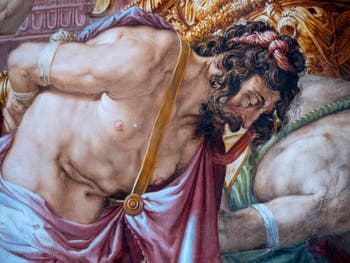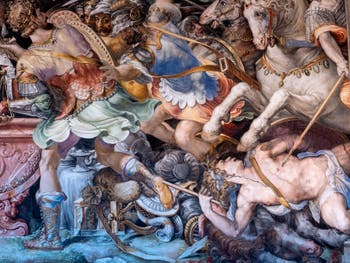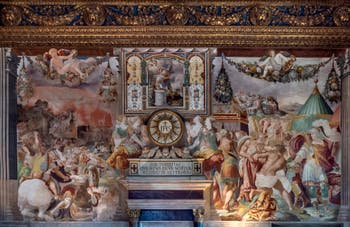Palazzo Vecchio Art Story | Location | Opening Hours Tickets | Authorizations
Art Story Five-Hundred | Tower | Vasari Halls | Dante Mask | Ghirlandaio | Bronzino Sarto Daddi | Salviati | Cortile
The Hearings Hall, “Sala delle Udienze” of the Palazzo Vecchio in Florence in Italy
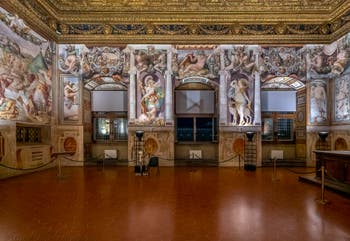
The Hearings Hall This room was originally much larger and included in addition to the current Gigli Hall, the Lily's Hall.
It was divided into two separate rooms in 1470 by the construction of a separation wall, with on one side this Hall of Hearings and on the other the dei Gigli Hall, the Lily’s Hall.
Works designed and carried out by Benedetto da Maiano.
As a result of this work, this courtroom was intended to bring justice to Florence.
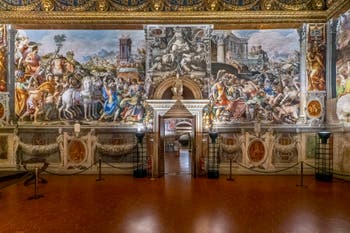
The Hearings Hall A marble statue depicting Justice overcomes one of the entrance doors to the hall with this inscription: “Diligite Iusticiam Qui Iudicatis Terram”.
Between 1470 and 1476, Giuliano de Maiano, assisted by Francesco Monciatti and Giovanni da Gaiuole, made the superb gold coffered ceiling in this courtroom.
The hall “delle Udienze” of Palazzo Vecchio is also richly and beautifully decorated with large frescoes by Francesco de' Rossi Salviati (1510-1563).
Frescoes that the artist painted between 1543 and 1545.
The pictorial revolution introduced by Francesco Salviati in Florence
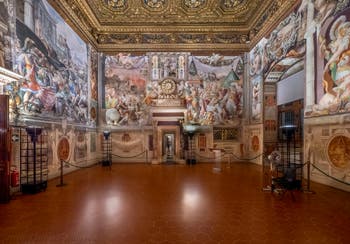
The Hearings Hall Salviati's murals were the origin of a small pictorial revolution in Florence that influenced many Florentine painters, including Giorgio Vasari.
They corresponded to the new Roman trend initiated by Raphael and superbly highlighted in his frescoes of the Vatican Rooms.
Frescoes in which Raphael, beyond their pictorial qualities, had also introduced ancient scenes related essentially to Emperor Constantine I, the first Christian Roman emperor, but also to antiquity as a whole as in his “School of Athens”.
Salviati was Florentine by birth, but his artistic formation was essentially Roman and, as such, is considered an authentic heir to Raphael's work.
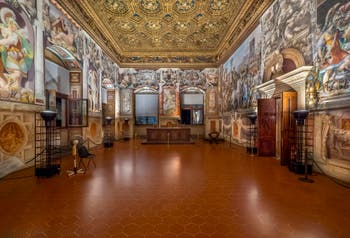
The Hearings Hall His frescoes highlight here his sumptuous decorative repertoire with dynamic scenes full of emotion and movement, able to give life to events of Roman antiquity, revisited in a contemporary way by the artist.
A style that was rich and overabundant in classic elements that are typically found in Roman mannerism.
What also strikes when you admire these frescoes is Salviati's ability to give relief to the characters and landscapes, to give them life with the line, but also through the use of bright and shimmering colours.
A palette of colours that characterises explicitly Salviati added to his introduction of chiaroscuro that will influence Giorgio Vasari in his own frescoes, which were much more academic before he saw and inspired those of Salviati.
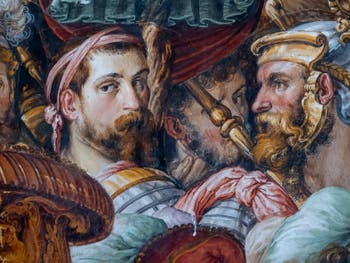
Salviati Self-portrait On the wall separating the Hearing hall from that of the Gigli, the Lilies, one can see on the left the “Triumph of Marco Furio Camillo” general and Roman statesman (446-365 BC) who succeeded in preventing the invasion of Rome by the Gauls.
The symbolic link created by Francesco Salviati between Rome and Florence in his two frescoes to the glory of ancient Rome, as Raphael had done in the Vatican rooms, was also intended to highlight the links between the papacy and the Medici, ties reinforced by the two Popes Medici.
The Self-portrait of Francesco Salviati
Thanks to the writings of Giorgio Vasari, it is also known that the moustachioed character with a forehead encircled with ribbons shot three quarters at the front of the winner's chariot and just under the arms trophies is none other than Francesco Salviati himself.Francesco Salviati: “The Triumph of Furio Camillo After the Taking of Veio” Hall of Hearings of the Palazzo Vecchio in Florence
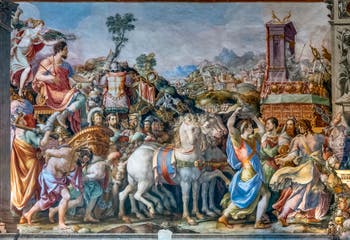
Triumph of Furio Camillo The first large fresco to the left of the entrance door to the room of the Lilies depicts the “Triumph of Furio Camillo after the capture of Veio”.
This “Triumph of Marco Furio Camillo” is obviously double reading.
It is indeed as much an allegory to the Roman general as to the glory and virtues of Duke Cosimo I of Medici.
To do this, Salviati introduced in his frescoes allegories of time and virtues.
Patience, and especially all the virtues officially attributed to Cosimo I and represented on the other walls of the hall.
The town of Veio was taken by General Furio Camillo by digging an underground tunnel, which allowed Camillo's troops to enter it without difficulty and submit Veio.
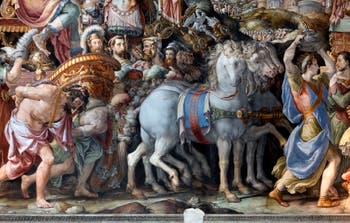
Triumph of Furio Camillo In the centre of the painting, just under the town of Veio and on the left of the temple to the glory of Juno, we can see the soldiers who are engulfing into the tunnel.
The winning general is represented on his quadriga returning to Rome, crowned by a goddess and surrounded by numerous trophies and prisoners with hands tied in his back.
The whole thing is painted in an exuberant style where details and characters accumulate, divine allusions and virtues.
With Francesco Salviati's declared desire to assimilate Duke Cosimo I of Medici with the famous Roman general in his fresco.
The decoration of this Hall of Hearings was one of the first great orders of Cosimo I to decorate the Palazzo Vecchio.
Francesco Salviati “The weighing of the gold of the Gauls and the intervention of Furio Camillo” Hall of Hearing of the Palazzo Vecchio in Florence
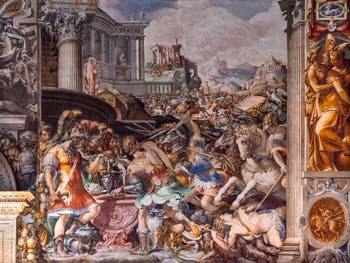
The weighing of the gold In this second fresco, Francesco Salviati depicted the episode in which the Romans, after the assault of the Gauls, agreed to pay a tribute of a thousand pounds of gold to their enemies in exchange for the liberation of Rome.
It was a moment of unbearable and humiliating shame for the Romans.
In this fresco, we see the king of the Gauls, Brennus, weighing gold while unbalancing the balance for his benefit. He is seen while he turns back as Furio Camillo's troops enter into action to assault the Gauls.
A fierce battle will follow.
You can see in the background the ruins of Rome with the statue of the Apollo of the Belvedere and a mutilated statue of Venus.
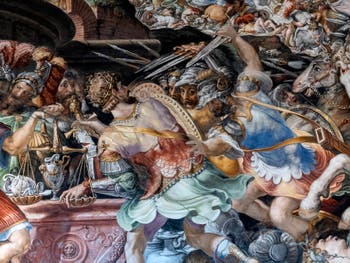
The weighing of the gold This fresco is a clear allusion to Duke Cosimo I of Medici and his decisive military victory at Montemurlo against the Florentine rebels and the French.
As a result of this final battle, Florence regained peace and managed to regain its independence, including from imperial claims.
Full independence with the emperor's restitution of the Florentine fortresses and peace and stability recovered thanks to Cosimo I de Medici and his governance.
The presence of the Statue of Justice above the door of the Hearings Hall must also be read as a representation of the existence of true justice in a ducal government rather than a Republican.
Art Story Five-Hundred | Tower | Vasari Halls | Dante Mask | Ghirlandaio | Bronzino Sarto Daddi | Salviati | Cortile
Palazzo Vecchio Art Story | Location | Opening Hours Tickets | Authorizations
Back to Top of Page


